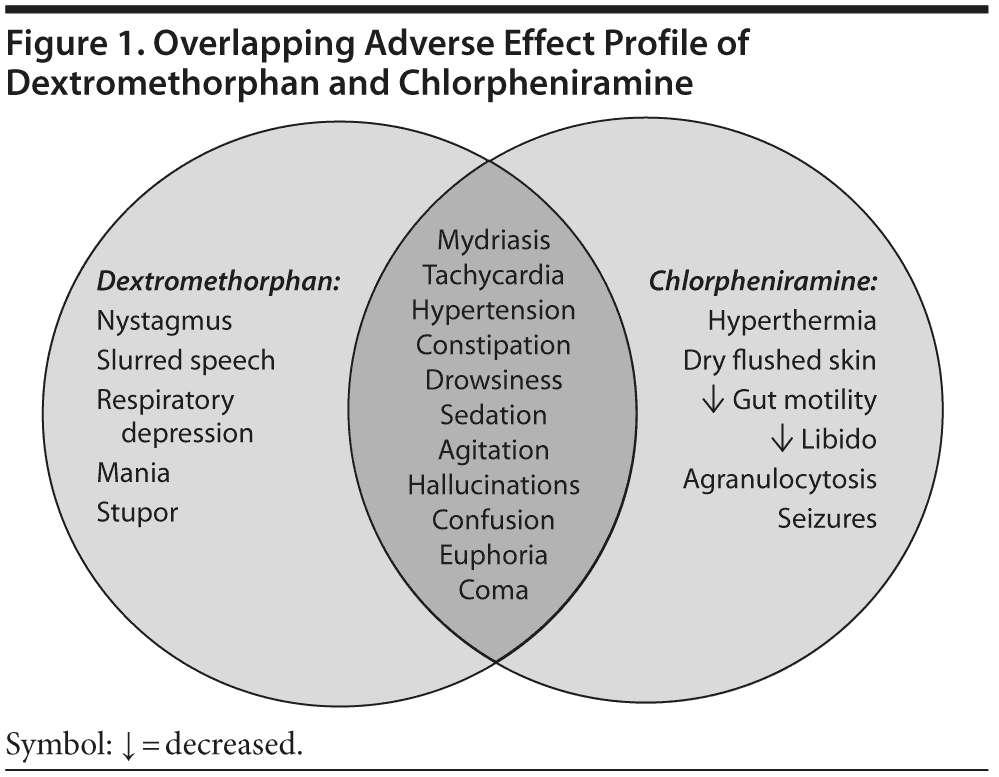A Case of Acute Psychosis Secondary to Coricidin Overdose
To the Editor: Dextromethorphan and chlorpheniramine maleate are common ingredients in over 140 prescription and over-the-counter cough and cold medicines, including CoricidinHBP. When used at recommended doses, they are safe and effective agents with minimal adverse effects. However, at higher doses, typically as a result of recreational abuse, dextromethorphan and chlorpheniramine are capable of inducing a specific toxidrome that includes various psychiatric sequelae such as euphoria, agitation, psychoses, dissociative phenomena, and, rarely, dependence.1 Some of the street names for CoricidinHBP (or specifically for the dextromethorphan component) are Red Devils, Robo, Triple C, Skittles, and poor man’s PCP. The street terms for illicit use are skittling and robo-tripping.2 The use of these terms stems from the commonly abused over-the-counter formulae Robitussin and CoricidinHBP. We present here the case of a patient who developed acute psychosis induced by an overdose of CoricidinHBP.
Case report. Mr A, a 40-year-old white man, was hospitalized in the intensive care unit for the management of acute psychosis and irritable mood. He was found at a supermarket exhibiting bizarre behavior after he had purchased and rapidly ingested about 30 tablets of CoricidinHBP. On arrival to the emergency department, he was tremulous and diaphoretic and demonstrated a clouded sensorium, euphoric mood, and circumstantial thought process. He stated that he could "look at people and know exactly what they were thinking" and displayed paranoid behavior. He had abused CoricidinHBP "to get high" off and on for the past several weeks.
He reported past use of marijuana, cocaine, methamphetamine, and opiates and had been previously diagnosed with alcohol dependence, in partial remission. His past medical history was nonsignificant, he had no drug allergies, and he was not on treatment with any prescribed medications. His past psychiatric history included DSM-IV polysubstance dependence. He had no family history of any psychiatric illness. A complete medical evaluation revealed a positive hepatitis C antigen test, elevated liver enzymes (alkaline phosphatase 277 U/L, aspartate aminotransferase 120 U/L), and negative urine toxicology screen. Findings of routine blood work were otherwise within normal limits. He was prescribed intravenous lorazepam 1-2 mg every 4 hours for agitation, which was gradually discontinued over a period of 2 days. His other medications included ondansetron and ranitidine for symptomatic relief.
Mr A’s clinical manifestations showed complete remission without the need for any antipsychotic treatment within 2 days after discontinuing CoricidinHBP. His mental status at the time of discharge was stable with no clinical evidence of psychosis.
CoricidinHBP is a cough and cold medicine that contains 30 mg of dextromethorphan and 4 mg of chlorpheniramine maleate per tablet. Previously, CoricidinHBP-induced psychosis was thought to be due to the sympathomimetic amines present in many preparations.3,4 However, it was later suggested that the causative agent is dextromethorphan.5
Dextromethorphan is metabolized by the hepatic cytochrome P450 isoenzyme 2D6 (CYP2D6) to its active metabolite dextrorphan.6 Dextrorphan has shown to have phencyclidine-like behavioral effects in animal models. Like phencyclidine, it is a strong non-competitive N-methyl-d-aspartate (NMDA) receptor antagonist. When it binds to and blocks these receptors, it can produce euphoria, hyperactivity, and psychosis. It is also an antagonist at the α3/β4 nicotinic receptors and an agonist at the opioid σ1 and σ2 receptors and targets the serotonin reuptake pump. Due to the genetic polymorphism of CYP2D6, patients can be slow or rapid metabolizers of dextromethorphan, and the latter group are more prone to neuropsychiatric manifestations.6 Acute intoxication with dextromethorphan can produce drowsiness, tachycardia, ataxia, agitation, hysteria, nystagmus, urinary retention, hallucinations, stupor, or coma.2
Chlorpheniramine maleate is an alkyl amine histamine H1 receptor antagonist that produces anticholinergic effects. Acute chlorpheniramine maleate intoxication can cause tachycardia, hyperthermia, urinary retention, confusion, altered coordination, agitation, hallucinations, seizures, or coma.2
The clinical manifestations of dextromethorphan and chlorpheniramine maleate overdose are overlapping, and both of the compounds most likely cause the constellation of symptoms in CoricidinHBP overdose (Figure 1).
Although dextromethorphan dependence is rare, it was reported among those who were chronically abusing the drug.2 It supposedly has no addictive qualities, although there are few reported cases of dependence and craving. One such case report described a patient who had abused cough syrup containing dextromethorphan for 8 years.7 He was hospitalized for a manic episode that resolved during a period of abstinence in which he reported craving for the drug. Once discharged, he recommenced the drug abuse and his cravings subsided. Another case described a patient who was snorting dextromethorphan powder for several months and, when hospitalized and off the drug, reported cravings.8 Although dependence characteristics and long-term psychiatric manifestations of the drug are not well established, dependence is a possible consequence with chronic use.
Due to the extensive and over-the-counter availability of CoricidinHBP, patients and health-care providers alike are largely unmindful of its potential toxidrome and dependence liability. Coricidin, with its psychiatric and physical manifestations, could have short-term and long-term health implications. Coricidin addiction must be managed like any other chemical dependency, and treatment strategies should be drafted to ensure the best chance of patient recovery.
References
1. Miller SC. Dextromethorphan psychosis, dependence and physical withdrawal. Addict Biol. 2005;10(4):325-327. PubMed doi:10.1080/13556210500352410
2. Banerji S, Anderson IB. Abuse of Coricidin HBP cough & cold tablets: episodes recorded by a poison center. Am J Health Syst Pharm. 2001;58(19):1811-1814. PubMed
3. Mendez MF. Mania self-induced with cough syrup. J Clin Psychiatry. 1992;53(5):173-174. PubMed
4. Craig DF. Psychosis with Vicks Formula 44-D abuse. CMAJ. 1992;146(7):1199-1200. PubMed
5. Schadel M, Sellers EM. Psychosis with Vicks Formula 44-D abuse. CMAJ. 1992;147(6):843-844. PubMed
6. Schadel M, Wu D, Otton SV, et al. Pharmacokinetics of dextromethorphan and metabolites in humans: influence of the CYP2D6 phenotype and quinidine inhibition. J Clin Psychopharmacol. 1995;15(4):263-269. PubMed doi:10.1097/00004714-199508000-00005
7. Weisman RS. Antihistamines and decongestants: dextromethorphan abuse and mania. BMJ. 1993;147:672-673.
8. Fleming PM. Dependence on dextromethorphan hydrobromide. Br Med J (Clin Res Ed). 1986;293(6547):597. PubMed doi:10.1136/bmj.293.6547.597
Author affiliations: Kurnool Medical College, Kurnool, Andhra Pradesh (Dr Aytha); Christian Medical College and Hospital, Vellore, Tamil Nadu (Dr Moorthy), India; Department of Psychiatry, Creighton-Nebraska Psychiatry Residency Program (Dr Dannaram); and Department of Psychiatry, University of Nebraska College of Medicine (Drs Aytha and Sharma), Omaha.
Potential conflicts of interest: None reported.
Funding/support: None reported.
Published online: November 21, 2013.
Prim Care Companion CNS Disord 2013;15(6):doi:10.4088/PCC.13l01549
© Copyright 2013 Physicians Postgraduate Press, Inc.






